Roy K.K. Potential theory in applied geophysics
Подождите немного. Документ загружается.

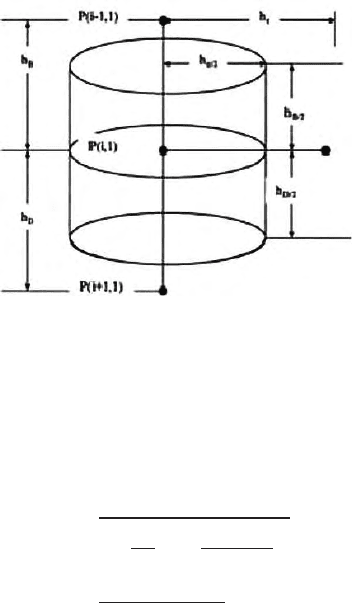
15.3 Finite Difference Formulation Domain with Cylindrical Symmetry 489
Fig. 15.10. An elementary volume near the point current electrode. On the axis of
a borehole
point source P
(1,1)
. The volume density of current q can then be easily cal-
culated by dividing the strength of current at any instance by the volume of
the cylinder.
Hence
q=
I
π
h
C
2
2
h
B
+h
D
2
(15.45)
=
8I
πh
2
C
(h
B
+h
D
)
(15.46)
In the (15.35) and (15.43), the current density factor q only comes in the
expression at the current source and sink nodal positions with + and − signs.
For other positions of the nodal points, including those occupied by potential
electro des, the factor q is zero. Here sources and sinks are considered on the
axis.
15.3.7 Evaluation of the Potential
The finite difference equation (15.35) and (15.43) constructs a large set of
linear equations considering each pivotal points of the discretized earth model.
Finally this large set of linear equations are arranged in a matrix form
A x = b (15.47)
where, A is the co n du ctivity coefficient banded sparse matrix, b is the column
vector where only non zero elements a re from the locations of the source and
sink.
The conductivity co-efficient matrix A is a pentadiagonal, asymmetric and
banded in nature, where four off diagonal and the main diagonal entries have
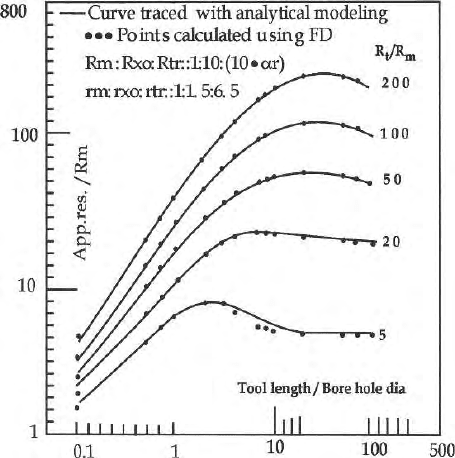
490 15 Numerical Methods in Potential Theory
Fig. 15.11. Comparison of analytical and finite difference modelling results
nonzero values. The remaining entries are all zeros. Direct solution of the
matrix equation can be done using one of the matrix solvers. For a thick bed,
Fig. 15.11 shows the apparent resistivity curves in the presence of flushed zone,
invaded zone and uncontaminated zone. Finite difference curves are compared
with those available in Schlumberger Well Surveying Corporation Document
(1972).
15.4 Finite Difference Formulation Plane Wave
Electromagnetics Magneto t ell urics
In the last two Sects. 15.2 and 15.3, finite difference formulations both for
surface a nd borehole geophysics are demonstrated for direct current flow field
domain in considerable details where the guiding e q uations were Poisson’s
equation.
In this section we have given a brief structure of the finite difference for-
mulations for plane wave electromagnetics using Maxwell’s equations and
Helmholtz electromagnetic wave equations as guiding equations. Boundary
conditions are considerably different in electromagnetics. Details of electro-
magnetic boundary conditions are discussed in the Chap. 12.
In Magnetotellurics (MT) two sets of field data in frequency domain are
obtained after continuous time domain recording o f electric and magnetic

15.4 Plane Wave Electromagnetics Magnetotellurics 491
fields in two mutually perpendicular north-south and east-west directions.
Theratiooftheelectricfieldtothetransverse magnetic field in frequency
domain are obtained after pro cessing and fourier transforming two sets of
time domain E and H fields. One gets impedances, viz, Z
xy
(= E
x
/H
y
)
and Z
yx
(E
y
/H
x
). Madden and Nelson (1960) proposed that magnetotelluric
impedance Z is actually a 2 × 2MTtensorwhereZ
xy
and Z
yx
are off
diagonal elements and Z
xx
and Z
yy
are diagonal elements. In 1967 Swift
brought the concepts of mathematical rotation of the MT impedance ten-
sor, optimum rotation angle and TE(Transverse Electric) and TM(Transverse
Magnetic) mode in 2 -D MT. Swift rotation (1967) equation is given by,
Vozoff(1972),
Z
′
=MZM
T
(15.48)
where,
Z
′
=
)
Z
′
xx
Z
′
xy
Z
′
yx
Z
′
yy
*
. (15.49)
The primed components denote the components of the impedance tensor Z
after rotation. Here
M=
)
cos θ sin θ
−sin θ cos θ
*
and (15.50)
M
T
is the transpose of M .
For a two dimensional (2-D) structures (see Chap. 2) as well as for opti-
mum rotation angle θ, the angle between the geographic north and the strike
direction of the 2-D structure, one gets Z
xx
=Z
yy
=0and
Z
′
xy
2
+Z
′
yx
2
=
maximum. The rotated apparent resistivity and phases are given by
ρ
′
axy
=0.2T
Z
′
xy
2
and ϕ
′
xy
=tan
−1
Im
Z
′
xy
Re
Z
′
xy
(15.51)
ρ
′
ayx
=0.2T
Z
′
yx
2
and ϕ
′
yx
=tan
−1
Im
Z
′
yx
Re
Z
′
yx
. (15.52)
Here the rotated primed parameters are the E and H polarization parameters.
They are ρ
TE
, φ
TE
and ρ
TM
, φ
TM
.
At optimum rotation angle, Helmholtz wave equation ∇
2
E
H
= γ
2
E
H
decouples into two separate independent sets of equations. TE or E
II
stands
for transverse electric or E-p olarization mode where electric field is paral-
lel to the geological strike. TM or E
⊥
stands for transverse magnetic or
H-polarization mode (Table 15.1). Here magnetic field is parallel to the
strike and electric field is perp endicular to the strike Figs. (15.12) and
(15.13 a, b) respectively show the strike direction in an ideal 2D mo d el
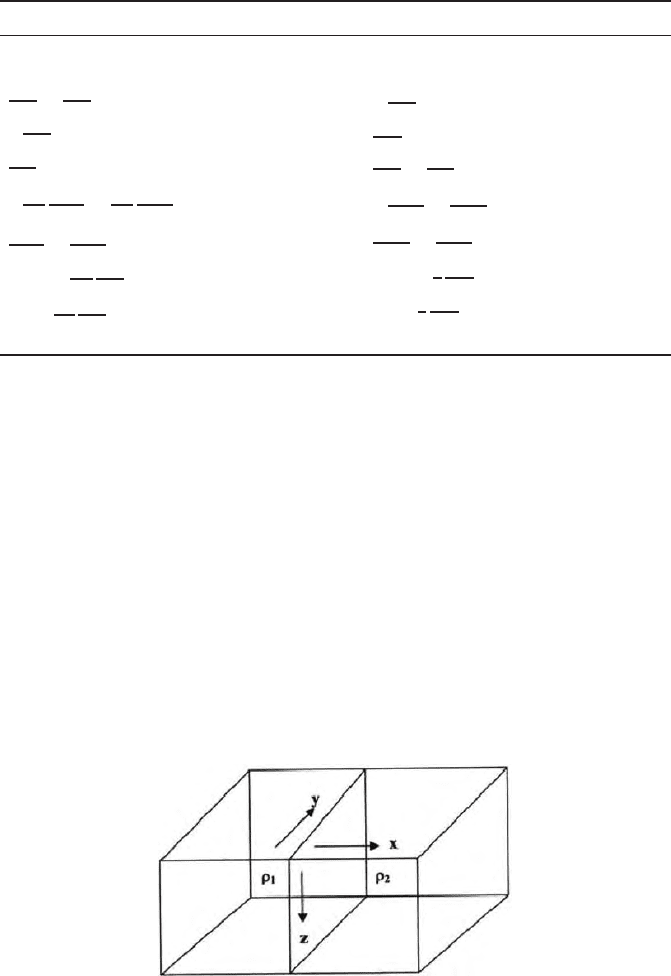
492 15 Numerical Methods in Potential Theory
Table 15.1. Break up of Helmholtz electromagnetic wave equation for E and H
polarisations
E-polarization equations H-polarization equations
i) E = E(0, E
y
, 0), H = H(H
x
, 0, Hz)
∂H
x
∂z
−
∂H
z
∂x
= σE
y
−
∂E
y
∂z
=iωµH
x
∂E
y
∂x
=iωµH
z
−
1
iωµ
∂
2
E
y
∂z
2
−
1
iωµ
∂
2
E
y
∂x
2
= σE
y
∂
2
E
y
∂x
2
+
∂
2
E
y
∂z
2
= γ
2
E
y
H
x
= −
1
iωµ
∂E
y
∂z
H
z
=
1
iωµ
∂E
y
∂x
i) E = E(E
x
, 0, Ez), H = H(0, H
y
, 0)
−
∂H
y
∂z
= σE
x
∂H
y
∂x
= σE
z
∂E
x
∂z
−
∂E
z
∂x
=iωµH
y
−
∂
2
H
y
∂z
2
−
∂
2
H
y
∂x
2
=iωµσH
y
∂
2
H
y
∂z
2
+
∂
2
H
y
∂x
2
= γ
2
H
y
E
x
= −
1
σ
∂H
y
∂z
E
z
=
1
σ
∂H
y
∂x
and the directions of electric and magnetic vectors in E-polarisation and H-
polarisation.
Since the low frequencies are involved in MT exploration, conduction cur-
rents dominate over displacement currents. The integral forms of Maxwell’s
equations in mks units can be written as
H.dl =
J.dS =
σE .dS (15.53)
E.dl =
iμωH .dS, (15.54)
where in general, σ and μ are scalars for a homogeneous and isotropic medium
and tensors for inhomogenous and anisotropic medium (Chap. 2). These
Maxwell’s equations and Helmholtz wave equations given in Chaps. 12 and 13
Fig. 15.12. A model of a two dimensional earth with a strike along the y direction;
ρ
1
and ρ
2
are the resistivities of the two blocks
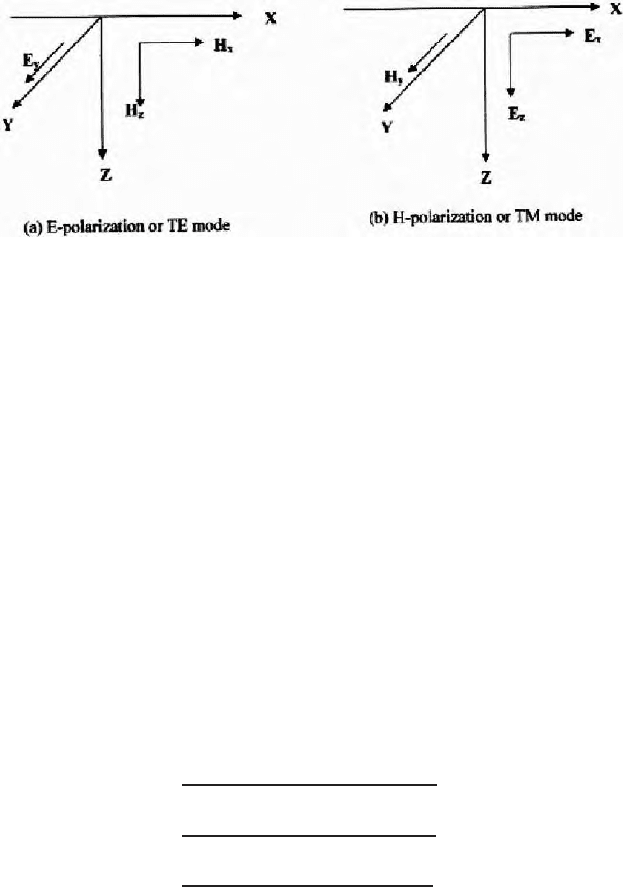
15.4 Plane Wave Electromagnetics Magnetotellurics 493
Fig. 15.13. Directions of electric and magnetic fields for E and H polarizations
and in Table 15.1 are used to generate the finite difference modelling struc-
tures. We can define a difference scheme such that (15.53) or (15.54) are
exactly satisfied. Finite difference scheme in Magnetotellurics proposed by
Mackie et al (1993) are as follows (Fig. 15.14 a,b)
a) The x, y, z components of (15.53) are
{[H
z
(i, j +1,k) − H
z
(i, j, k)] −[H
y
(i, j, k + l)
−H
y
(i, j, k)]}L = J
x
(i, j, k) L
2
{[H
x
(i, j, k +1)−H
x
(i, j, k)] − [H
z
(i +1,j,k)
−H
z
(i, j, k)]}L = J
y
(i, j, k) L
2
(15.55)
{[H
y
(i +1,j,k) − H
y
(i, j, k)] − [H
x
(i, j +1,k)
−H
x
(i, j, k)]}L = J
y
(i, j, k) L
2
{[E
z
(i, j, k) − E
z
(i, j −1,k)] − E
y
(i, j, k)
−E
y
(i, j, k −1)}L = iω < μ
xx
>H
xx
(i, j, k) L
2
(b)
E
x
(i, j, k)=
[ρ
xx
(i, j, k)+ρ
xx
(i −1,j,k)]
2
J
x
(i, j, k) ,
E
y
(i, j, k)=
[ρ
yy
(i, j, k)+ρ
yy
(i, j − 1,k)]
2
J
y
(i, j, k) , (15.56)
E
z
(i, j, k)=
[ρ
zz
(i, j, k)+ρ
zz
(i, j, k − 1)]
2
J
z
(i, j, k) .
(c)
{[E
x
(i, j, k) − E
x
(i, j, k −1)] −E
z
(i, j, k)
−E
z
(i −1,j,k)}L = iω < μ
yy
>H
yy
(i, j, k) L
2
{[E
y
(i, j, k) − E
y
(i −1,j,k)] − E
x
(i, j, k)
− E
x
(i, j − 1,k)}L = iω < μ
zz
>H
zz
(i, j, k) L
2
(15.57)
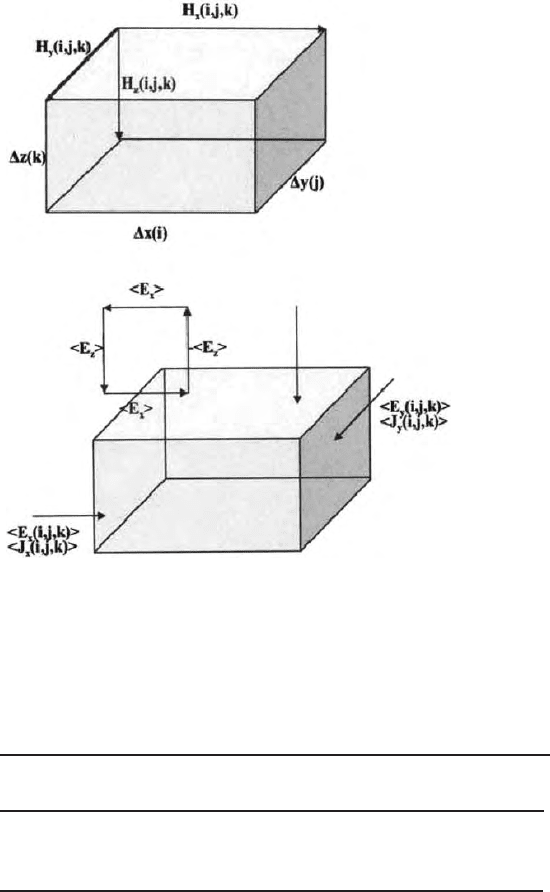
494 15 Numerical Methods in Potential Theory
Fig. 15.14. a,b Magnetotelluric finite difference rectangular parallelepiped cells
showing the direction of electric and Magnetic Fields (Mackie ,Madden and Wan-
namaker 1993)
where we define the permeabilities as :
<µ
xx
> =
µ
xx
(i, j − 1,k− 1) + µ
xx
(i, j, k − 1) + µ
xx
(i, j − 1,k)+µ
xx
(i, j, k)
4
<µ
yy
> =
µ
yy
(i − 1,j,k− 1) + µ
yy
(i, j, k − 1) + µ
yy
(i − 1,j,k)+µ
yy
(i, j, k)
4
(15.58)
<µ
zz
> =
µ
zz
(i − 1,j− 1,k)+µ
zz
(i − 1,j,k)+µ
zz
(i, j − 1,k)+µ
zz
(i, j, k)
4
Here ρ and µ the resistivity and magnetic per meability are chosen to be
tensors. E is defined as the average along a co ntour and H is defined as the
average ac ross the surface enclosed by the contours Once the basic equations
for TE and TM mode are available and the guide lines to prepare the difference
15.4 Plane Wave Electromagnetics Magnetotellurics 495
equations from Maxwell’s equations are obtained one can frame the finite
difference formulation program .
15.4.1 Boundary Conditions
In TE mode, the boundary conditions are not simple as E
x
,H
y
and H
z
are all
continuous across the air – earth interface. Consequently, the horizontal H field
is not constant everywhere above the ground in the vicinity of a lateral inho-
mogeneity. Thus, it is necessary to consider air layers above the ground . An
upwar d extension of the model cross section upto the air – ionosphere bound-
ary is necessary in an attempt to get numerical solutions for E polarization
problem. This requires an interface, where lateral changes in conductivity do
not exist. Since we need H
z
=0andE
x
is constant, a n d ∂E
x
/∂y = iωμ
o
H
z
,
ten air layers are generally introduced(Wannamaker 1987). They are the rows
next to the air – earth interface and are of the same height as the rows just
be l ow the surface under the assumption that electric current flow across the
air – earth interface is negligible. These 10 air layers above the surface of the
earthwithexponentialincreased thickness in some cases are chosen such that
the geometric perturbations in the longest wavelength H field gets damped.
On top of the air layer an arbitrary electric field E o is assumed. Since all the
fields at different depths get normalised, the arbitrary choice is permissible.
The lower half space below the air earth boundary are chosen in such a way
such that Eo = 0 at the bottom. Generally Eo is chosen as 1 above the air lay-
ers. For TM mode modelling air layers are not necessary. Ho also is assumed to
be 1(Ho = 1). The boundary values on the side faces of the model are chosen
from the values obtained from 1D on the surface of the earth. At the bottom of
the half space Ho also is assumed to be zero. Once the boundary conditions are
imposed one gets a series of equations which can be clubbed together to get a
matrix
Ax = b, (15.59)
where b contains terms associated with the known boundary values and source
field. This system of equations is sparse, symmetr ic and complex (a l l ele-
ments are real except for the diagonal elements). Once this system has been
solved for the H fields, the E fields can be determined by application of curl
H =J=σE neglecting the displacement c u rrent as mentioned. The values of
the electric and magnetic field on all the nodes in the model are obtained.It
is interesting to note that the column vector in this case has mostly nonzero
elements.The matrix A is symmetric in this case. In the DC domain, the
matrix A is asymmetric These considerable difference in boundary condi-
tions and formulation do exist between direct current and electromagnetic
field domain. Choice of matrix solver may be different. Otherwise step by
step structure of the FD formulation in both the cases are more or less the
same.
496 15 Numerical Methods in Potential Theory
15.5 Finite Element Formulation Direct Current
Resistivity Domain
15.5.1 Introduction
The basic concept in the finite element method is that a continuous space
domain, is assumed to be composed of a set of piecewise continuous functions
defined over a finite number of subdomains or elements. The piecewise con-
tinuous space called elements and any function say potential or field or stress
or strain are defined using values of continuou s quantity at a finite number
of point in the sol u ti on domai n assuming linear or nonlinear variations in
polynomials. Discretization of the space domain, elements, nodes, bo u n dary
conditions, use of matrix solver are more or less same as those we discussed in
Sect. 15.2 a nd 15.3. But the solution of the problem in finite element (FEM)
domain is considerably different from what we have seen in Sect. 15.2 and 15.3.
The steps involved in formulating a problem in the finite element domain may
be summarised as follows:
1) The solution domain is made finite and divided into a finite number of
elements, each having suitable physical property assigned. These elements may
be one, two, or three-dimensional according to the problem being considered.
The shape of the elements can be one of the many different forms (Zienkiewicz,
1971) viz., triangle, quadrilateral, rectangle, square, tetrahedron, cube, paral-
lelepiped etc with straight or curved boundaries. 2) The elements are intercon-
nected at common nodal points situated at the element boundaries or vertices.
A parameter for the unknown potentials to be determined is assigned to each
of these elements, and the potentials will be obtained from these nodal points.
3) A polynomial function is chosen to define the behaviour of potential field
within the element, in terms of the nodal values. The interpolating polyno-
mial may b e linear, quadratic, or cubic. 4) The approximating p olynomial
functions are then substituted for the true solution into the equation describ-
ing the potential or field behaviour. 5) The summation of all the elemental
equations gives an approximation to the equation for the continious potential
function. A system of equations is obtained from which the nodal potentials
may be obtained. 6) One of the approaches viz, Rayleigh Ritz energy mini-
mization method based on variational calculus or the Galerkin’s weights are
chosen. 7) Natural coordinates with isoparametric elements are also used to
bring in curved boundaries. In the p resent finite element approximation, the
cross-section of a 2-D structur e is represented by a number of triangular ele-
ments. Inside each of these elements a linear behaviour of potential field is
assumed. The nodes of the elements are situated at the vertices of the triangles
to which these variables are assigned. The approximation of a two dimensional
field variable φ, within an element, e, may be written in terms of the element
unknown parameters φ
e
as,
φ
e
=
N
β
φ
β
(15.60)

15.5 Finite Element Formulation Direct Current Resistivity Domain 497
where β =i, j, k,.........r, r is the number of unknown parameters and
N
β
, β =i, r are the element shape functions.
The element shape functions cannot be chosen arbitrarily because these
functions have to satisfy the continuity and convergence requirements of the
method. More details concerning the types of element shape functions ar e
given in Kardestuncer (1987).
One can derive the finite element form of the governing differential equa-
tion of a problem in different ways. In the present finite element analysis the
variation al approach is used where a functional is minimised. In the next sec-
tions, GalerKin’s method of finite element analysis without and with use of
the isoparametric elements are demonstrated.
In this Rayleigh-Ritz approach, a physical problem, governed by a differ-
ential equation, may be equivalently expressed as an extremum problem by
the method of calculus of variations. For the steady state field problems, the
field equation to be solved is the quasi harmonic equation expressed in general
terms as
∂
∂x
σ
x
∂φ
∂x
+
∂
∂y
σ
y
∂φ
∂y
+
∂
∂z
σ
z
∂φ
∂z
= −∇.J
s
(15.61)
It is shown, by means of the calculus of variations, that a physical problem
defined by the above differential equation is identical to that of finding a
function φ, that minimizes a functional ψ. The same boundary conditions
applied to the differential equation are applicable to this integral equation
ψ =
)
σ
z
∂φ
∂x
2
+ σ
y
∂φ
∂y
2
+ σ
z
∂φ
∂z
2
− 2φ∇.J
s
*
dν. (15.62)
Minimization of this functional with respect to the unknown function φ,gives
the potential φ, which also satisfies the differential equation (Coggon 1971).
In this resistivity problem, this integral is associated with power dissipation
within the conducting medium. The minimum condition thus requires that
the potential distribution within the medium is such that the power dissi-
pated (Joule heat in this case) is minimum Reddy (1986). A brief derivation
of the power integral expressed in terms of potential and suitable for direct
applications of the finite element method is given. Inverse fourier cosine trans-
form discussed in Sect. 15.2 regarding transformation of line source p otential
to point source potential is applicable here also
15.5.2 Derivation of the Functional from Power Considerations
Coggon (1971), Mwinifumb o (1980), Reddy (1986), Silvester and Haslam
(1972), Zienkiewicz and Taylor (1987) have presented the mathematical treat-
ments of the approaches based on the variational calculus. This mathematical
treatment is given by Mwinifumbo (1980) The power dissipated per volume
ψ
c
in a conducting medium with resistivity, ρ and current density, J
c
,is
498 15 Numerical Methods in Potential Theory
ψ
c
= ρJ
2
c
. (15.63)
The relations J
c
= σE, and E = −∇φ allow the equation to be written as
ψ
c
= σ(∇φ)
2
(15.64)
If there is a current source within the volume, the power dissipated per unit
volume by the source is
ψ
s
= −J
s
.∇φ. (15.65)
The power supplied by the source to the field is equal to the total power
dissipated as Joule heat, that is,
σ(∇φ)
2
+J
s
.∇φ =0. (15.66)
We wish to minimize the power dissipated within a volume where there
is a source, but the function describing the dissipated power and the power
supplied by the source is zero. This problem is handled by a method similar
to the Lagrangian multiplier method. Instead of minimizing the Joule heat
directly (which does not have the source terms), we construct a new function
as follows
σ(∇φ)
2
+J
s
.∇φ = 0 (15.67)
which in essence is just the negative of the power supplied to the unit volume.
The integral form of power dissipation within the solution domain is then
given as
ψ =
ν
σ (∇φ)
2
+2J
s
.∇φ
dν. (15.68)
Using the identity
∇.(φJ
s
)=J
s
.∇φ + φ∇.J
s
(15.69)
the first term on the right hand side of (15.69) may b e written as
ν
(J
s
.∇φ)dν =
ν
[∇. (φJ
s
) −φ∇.J
s
]dν. (15.70)
Applying the divergence theorem to the first term on the right hand side of
this equation, we have
ν
(J
s
.∇φ)dν =
ν
φJ
s
.nds −
ν
φ∇.J
s
dν (15.71)
since there are no sources on the surface of the solution domain, the surface
integral vanishes, then
ν
(J
s
.∇φ)dν = −
ν
φ∇.J
s
dν. (15.72)
